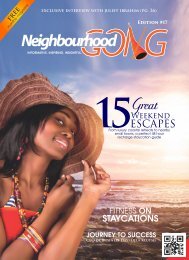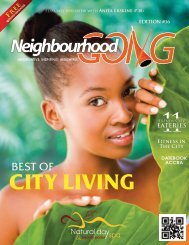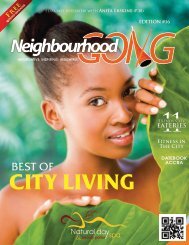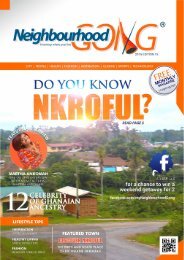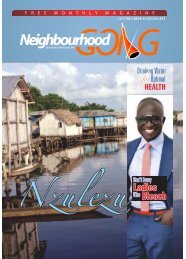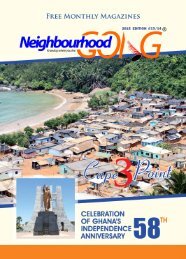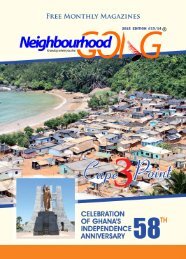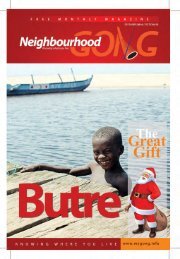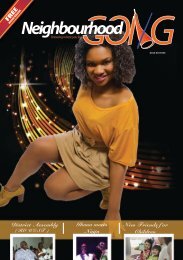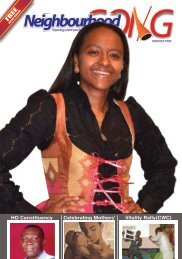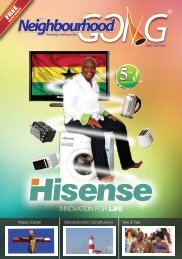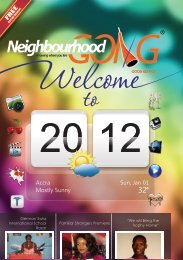Edition 9
You also want an ePaper? Increase the reach of your titles
YUMPU automatically turns print PDFs into web optimized ePapers that Google loves.
WHERE DO YOU LIVE?<br />
8<br />
WWW.NBGONG.NET<br />
Mole national park<br />
n this edition of “where do you live”, we give you a<br />
general overview of the Northern Region of Ghana<br />
Iand in subsequent editions take it constituency by<br />
constituency for effective and extensive coverage.<br />
Batakari<br />
Paga<br />
The Northern Region is the largest area of Ghana and<br />
occupies an area of about 70,383 square kilometers in<br />
terms of land area. The land is mostly low lying except<br />
in the north-eastern corner with the Gambaga<br />
escarpment and along the western corridor. The<br />
region is drained by the Black and white Volta and their<br />
tributaries, Rivers Nasia and Daka.<br />
Tamale, the capital, is the country's fourth largest city<br />
and the obvious gateway to the northern region. The<br />
region is bounded on the north by the Upper East and<br />
Upper West regions, on the west by Cote D'Ivoire and<br />
on the east by Togo. The regions on the south are the<br />
Brong Ahafo and Volta region. The main ethnic groups<br />
are Dagomba, Nanumba, Mamprusi, Gonja and<br />
Kokombas. Other groups include Chekosis, Bimobas<br />
and Vaglas. It is the nerve centre of all commercial<br />
activities in the whole of the Northern Sector of Ghana.<br />
Tamale is an incredible juxta-position of the ancient<br />
and modern. The traditional architecture of round huts<br />
with conical thatched roofs are sights to see. It is also<br />
the home of Ghana's first University of Development<br />
Studies.<br />
Between May and October is the wet season, with an<br />
average annual rainfall of 750 to 1050 mm (30 to 40<br />
inches). The dry season is between November and<br />
April. The highest temperatures are reached at the end<br />
of the dry season, the lowest in December and<br />
January. However, the hot Harmattan winds from the<br />
Sahara blows frequently between December and the<br />
beginning of February. The temperatures can vary<br />
between 14°C (59°F) at night and 40°C (104°F) during<br />
the day.<br />
The Northern Region was a major arena of slave<br />
raiders and a key supply source for slaves who were<br />
sent to markets and sold to local merchants from the<br />
South. They were subsequently marched on the coast<br />
and resold to European traders for export<br />
The Northern Region is the least densely populated<br />
area of Ghana. Most inhabitants (52%) speak a<br />
language of the –Mole Dagbani subfamily in the<br />
––NigerCongo languages. The people of the North<br />
have the Supine Temperament; they are very<br />
serviceable and friendly. Besides their local language,<br />
English is also widely spoken; you<br />
will not be a stranger when you get<br />
to the north. Please do not be<br />
surprised when you have people<br />
bowing to greet you, it is the<br />
lifestyle of the people and a mark<br />
of respect. For their belief system,<br />
women marry at a very early age.<br />
The women in the Northern<br />
Region of Ghana are very<br />
beautiful and the men are not bad<br />
either.<br />
Agriculture, hunting, basket<br />
weaving and forestry are the main<br />
economic activities in the region.<br />
Though there are good roads in<br />
the North, the people use bicycles<br />
for their daily commutes, the<br />
“busanga” type of cycles with a<br />
carrier; it makes their work a lot<br />
easier. The only part of the country<br />
you see women on cycles as well.<br />
In fact, it is the number one means<br />
of transportation, it is fun when<br />
you sit behind and someone rides<br />
you. Try it when you visit the North.<br />
Northern Regional Minister<br />
The main dishes of the Northern<br />
Region includes: Waakye, "TZ or<br />
"Tuo Zaafi" rice balls or "Omo Tuo"<br />
with groundnut or green leaves<br />
soup, beans or cowpea with<br />
sheanut oil and pepper called<br />
"Tubaani" "Koko" or millet or corn<br />
porridge eaten with "Koose" fried<br />
bean balls, you can wash it all<br />
down with "Pito", a locally brewed<br />
beer from millet, "Zom koom", or<br />
toasted millet flour in water and<br />
"fula" mashed in water, milk,<br />
ginger, other spices and sugar. I<br />
really enjoy “fula” because of the<br />
spices mixed up with the millet<br />
and besides it is highly nutritious.<br />
You can also try this delicacy;<br />
“akomfe” (Grilled Guinea fowl)<br />
with “pito” on Ice whiles relaxing,<br />
hahahahahaha!<br />
There are lots of fascinating and<br />
interesting places in the Northern<br />
Region you can visit for leisure.<br />
The Mole National Park offers a<br />
great Safari-like experience and is



